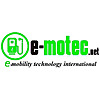
E-Motec
426 FOLLOWERS
A publication giving you insights behind the technology progressing the new era of clean sustainable mobility. Discover brand new solutions to new challenges, and meet the industry innovators pushing boundaries to make E-mobility a reality.
E-Motec
13h ago
Diving into the Essence of LiDAR Technology Luigi Ghezzi The automotive industry is at the forefront of technical evolution with Advanced Driver-Assistance Systems (ADAS) emerging as a main technology. Beyond reshaping how we use vehicles; autonomous driving will also allow us to optimize energy consumption on our routes. Already, the first cars featuring ADAS Level […]
The post Diving into the Essence of LiDAR Technology appeared first on E-Motec ..read more
E-Motec
1w ago
Why the human still matters in the development and validation of the next generation of ADAS
Salman Safdar
The advent of ADAS features has unleashed significant challenges for the already overstretched test and engineering departments within the automotive industry. The pursuit of establishing trust between the human occupant and the ADAS-driven car ‘brain’ has become a paramount objective for OEMs and Tier Ones. However, the pivotal question arises when ADAS systems and sensors face limitations in accurately interpreting the true road conditions. It’s this quandary that’s prompting a shift in ..read more
E-Motec
2w ago
How latest developments in laser welding improve weld quality while still maximizing throughput speed and yield
Jeff Franks
As the global push for sustainable transportation gains momentum, the spotlight increasingly falls on battery technology – both its potential and its challenges. The transition to electric vehicles hinges on the ability to produce batteries that are not only powerful and long-lasting, but also environmentally sustainable and economically viable.
These goals often create conflicting sets of demands that manifest themselves in every phase of battery production – from sourci ..read more
E-Motec
2w ago
Switching ON an electric future
or
The role of fluids in advancing electric mobility
Dr Marc Payne, Senior Manager, Advanced Electrification Research, bp
Industry reports suggest that by the mid-2030s, the majority of cars sold globally will be electric. Lubricating fluids in electric vehicles differ significantly from ICE lubricants due to the nature of the environment in which they operate. Therefore, to support the transition to an electric future, the lubricant industry (including Castrol) is diversifying into EV fluids that include e-transmission fluids, e-coolants / e-thermal fluids, and ..read more
E-Motec
3w ago
Assessing Technologies for Dielectric Protection of Battery System Components
Eric Dean
Governments and vehicle manufacturers around the globe are pledging to transition from internal combustion engines to electric vehicles (EV). As EV manufacturers continue to vie for more market share, they must alleviate certain consumer fears, one of which is range anxiety.
To reduce anxiety, EV manufacturers are increasing energy density and in turn, mileage. With the growth and development of battery pack technologies, a greater emphasis is placed on pack design optimization, with manufacturers seeking m ..read more
E-Motec
1M ago
How powder coatings are supporting the safety and performance of electric vehicle (EV) batteries and systems
Yidong Meng
Since the wheels of the first electric vehicle started rolling more than a century ago, development has been slow, and painfully so. It wasn’t really until the launch of the Nissan Leaf in 2010 that an affordable EV became available to a wider audience. More recently, there has been significant progress. In 2022, EV sales exceeded ten million, with 14% of all new cars sold being electric (up from 9% in 2021 and less than 5% in 2020). While final figures are yet to be analyse ..read more
E-Motec
1M ago
Take charge – overcome EV charging challenges with the cloud
Dick Kronman
As the global electric vehicle (EV) transition continues to gain pace, it remains to be seen how operators will be able to manage the associated, typically unmanned global charging infrastructure and ensure a seamless 24/7/365 operation.
But there is a solution. By migrating to the latest cloud-based energy services, operators can access the real-time intelligence needed to ensure the productivity of assets and predict future maintenance requirements. Here, Dick Kronman, Global Solution Technology Manager, Digital System ..read more
E-Motec
1M ago
Building solid roots for the EV transition: the role of kWh- based billing in fast charging infrastructures Integrating energy metering and legal metrology into EV fast charging stations is essential to deliver accuracy, transparency and trust
Florent Balboni
The transition from internal combustion engines (ICEs) to electric vehicles (EVs) sets a range of new challenges for societies, particularly in determining how and where to deliver the most efficient EV charging. Because EVs can be charged in numerous locations and through various methods , it is essential for end users to have a thorough ..read more
E-Motec
1M ago
Smart battery designs require new, reliable and robust processes – processing of thermally conductive potting compounds by using a direct injection process
Dr Michael Karcher
Thermally conductive materials are used for numerous applications in which efficient thermal management is required. They dissipate heat in a targeted manner and help to maintain the performance and reliability of systems – in electronic components and parts as well as in the rapidly growing field of electromobility applications. In view of the development of high-voltage batteries with high performance and other requirem ..read more
E-Motec
1M ago
Battery testing: what’s next?
Christopher Giehl and Andre Braun
Testing of battery raw materials and semi-finished products takes battery quality, processing, scaling and safety to the next level.
Common battery test procedures involve a range of electrical, mechanical, environmental, and safety evaluations to determine performance, durability, and resilience of batteries under various conditions. Well-known tests include capacity and cycle life assessments, vibration and shock resistance, temperature and humidity effects, and safety protocols like overcharge, short circuit, and thermal abuse ..read more